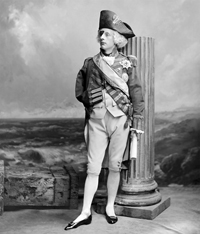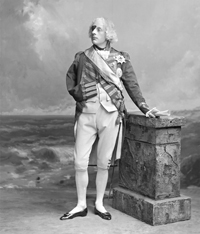Hon William Reginald Fitzwilliam (1862-1906),
The Hon William Reginald Wentworth Fitzwilliam was the youngest male child of the 6th Earl Fitzwilliam’s 14 children. When in 1894 his father paid off his debts and that of his wife (amounting respectively to the enormous amounts of £4,000 and £10,000), his allowance was cut back to £1,200 p.a. Believing that his trustees would bail him out again in the future, he and his wife kept living beyond their means. Having grown up in his father’s 365-room country house, Wentworth Woodhouse, near Rotherham in Yorkshire, he was an unrepentant spender and, in his own words to the bankruptcy court in 1900, he relied on the ideology of the leisured class by way of excuse, stating to the court that he “had never been engaged in any business or had any profession or occupation, and lived on an allowance from his father”. For the Ball, Fitzwilliam impersonated Admiral Lord Nelson (1758-1805) - one of the greatest naval heroes in British history. The anonymous costume designer would have had a wealth of images of Nelson, along with records kept in military precision of Nelson’s costume. However, just 9 years earlier, Sultan Abdülhamid II of Turkey made a gift to the National Portrait Gallery of Horatio Nelson, Viscount Nelson, of Acquarone’s copy of Leonardo Guzzardi’s 1799 portrait of the admiral. Nelson sent the original to Sultan Selim III as a token of his gratitude for presents given to Nelson by the Sultan. On his hat, Fitzwilliam wears a theatrical representation in satin of the diamond chelengk (Plume of Triumph) awarded to Nelson by the Sultan Selim III after the Battle of the Nile in 1798 and claimed to be the first ever “presented to any but victorious Mussulmans.” According to Nelson’s biographer Pettigrew, the 13 diamond-covered fingers of this ornament “were intended to represent the 13 ships taken and destroyed at the battle [of the Nile]. The centre diamond and the four surrounding it were estimated at the value of £5,000.” The centre diamond of the original order also turned around, operated by a clockwork. In the upper photograph, Fitzwilliam stands, scroll in hand, in front of a truncated Corinthian column against a seascape backdrop (which was adapted for the Lady Wolverton as Britannia portrait). The Westminster Gazette described his appearance as “a very realistic Nelson, arm and eye wanting, as in the original.”He leads: we hear our Seaman’s call George Meredith (1828–1909), Trafalgar Day |
Click on image to enlarge Click on image to enlarge
|
||
|

 V&A Lafayette Archive
V&A Lafayette Archive V&A Lafayette Archive
V&A Lafayette Archive